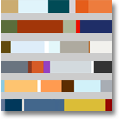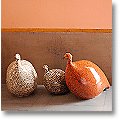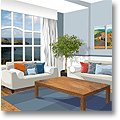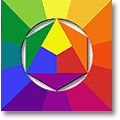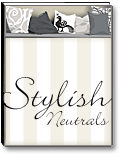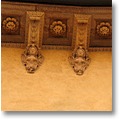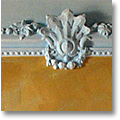Wall Color Ideas: How To Avoid The
'Crayon Box Explosion' Look
Wall color ideas for a natural look & feel? (Reader Question)
Hi Renate,
Is there a trick to choosing "natural" looking nature-inspired colors for walls instead of them looking like a crayon box explosion?
I love a beautiful piece of blue-green seaglass, but can that possibly translate into true-to-nature, mature wall color ideas?
Would a tinge of grey add realism?
How about texturizing or faux finishes?
THANK YOU!
Carmen
(USA)
(P.S. I have espresso colored cabinets, super blonde floors, medium to dark wood furnishings, and neutral fabrics.)
Hi Carmen,
your general color scheme sounds great, and I think your ideas for addressing the wall color issue are spot on.
There are basically three ways to nature-inspired, natural looking wall color ideas. You can create walls that look 'real' by ...
- manipulating the topcoat paint color,
- adding texture to the paint, or to the wall, and
- layering paint colors.
Wall Color Ideas, Part I:
Manipulating Paint Color For Walls
You can add liveliness, complexity and sophistication to wall painting colors by mixing them with a bit of ...
- gray (this will mute your paint color slightly, but strangely, will bring it to life at the same time) - or:
- brown/ochre/raw umber (this will muddy the color & give it an 'earthy' cast) - or:
- a related hue (this will create a subtle color bias) - or:
- its complementary color (this will discolor a hue slightly, and make it look more complex and lively).
Depending on the results you want to achieve, you can use all four methods together. However, there are two risks when you mix wall color ideas in this way:
1. If you throw too many hues together, you can end up with wall painting colors that just look murky and 'nothingy'.
2. You will need other complex, subtle wall painting colors in the vicinity of this paint color. If you use clear, simple hues on other walls or on the furniture/floor coverings, then your elegant, sophisticated, creative wall color ideas will just look grubby by comparison.
Wall Color Ideas, Part II:
Adding Texture To Wall Painting Colors
There are loads of faux wall texturing techniques, and you will find a lot of them explained and demonstrated on the 'Net. They all add a measure of shadow to a surface, and paint color for walls tends to look more 'alive' through that added shadow. Let me just cover two of those techniques here:
a) Mix latex wall paint with silica sand (you can buy it in different degrees of fineness; the finer the sand, the finer the texture on your wall).
Apply the paint/sand mix with a low-pile or sponge roller. This technique works at any gloss level. During the painting process, you have to keep stirring the paint as the sand will settle on the ground of the tub. There's no fixed sand-to-paint ratio for the mixture - you just experiment until you have a degree of texture that you're happy with. Alternatively ...
b) paint under and over crinkled tissue paper: Scrunch up and gently unfold a square of tissue paper and smooth it down onto a patch of freshly painted wall, with the wall paint still wet.
Then roller-paint over the crinkles, leaving them to form an interesting textured pattern on the wall (you can push the paper around on the wet wall, using your fingers to manipulate the look and direction of the crinkles). Add the next piece of tissue paper so that it overlaps the first. Work your way methodically sideways/down a wall, until the surface is completely crinkled up ;-)
Wall Color Ideas, Part III:
Layering Paint Color For Walls
The basic idea is to combine two (or more) wall painting colors so that one peeks out from underneath the other. This creates an illusion of depth, and the variation in paint color hues gives a 'natural', organic impression.
The technique works best, and looks the most natural, if you combine two wall painting colors that are quite close in tone and/or hue, e.g. one is a tad lighter than the other, or one contains a little more green than the other. You can
a) colorwash a liquid, transparent topcoat glaze over a basecoat, wiping it on with a sponge, brush, or rag . This would give you a 'glassy', watery effect and add beautiful depth to a wall. There's a good description of how to faux paint at Home Decorating & Remodeling, an excellent, information-rich site (the article also contains several ways of how not to faux paint ;-)
Alternatively to colorwashing, you could ...
b) sponge or rag a more viscous, less transparent paint over a basecoat. The 'drier' and thicker your paint is, and the more you dab a sponge or roll a scrunched-up rag (rather than 'wiping' the topcoat onto the wall), the more you will create a 'stippling' effect with defined borders to each stipple.
Like the other tricks above, the "layering" techniques all help take the synthetic edge off commercial wall colors. For the best possible results with these wall color ideas, always make sure you will have uninterrupted time to finish every wall in one go, while the paint is still wet.
For more information and ideas on how to manipulate the appearance of paint on your wall, have a look at Painting Ideas & Techniques, a website written by an experienced Dutch painter. She shares a motherlode of additional interior painting tips and interior painting techniques that are bound to give you great results.
Good Luck!

Check out this Mini Bookshop, too (in partnership with Amazon):
Yet to find the information you're looking for? Type a word or phrase into the search box below:
